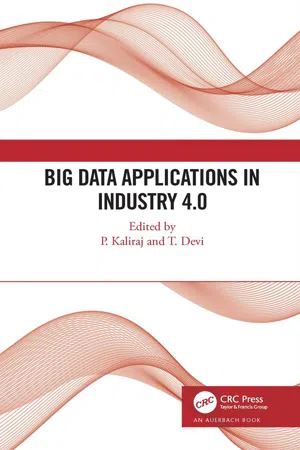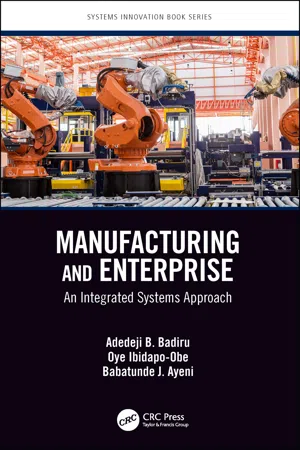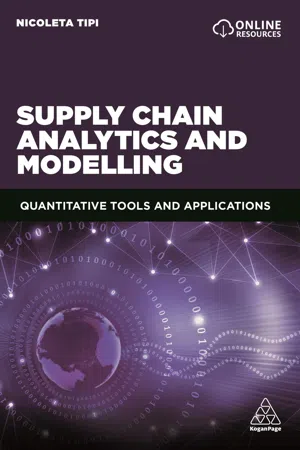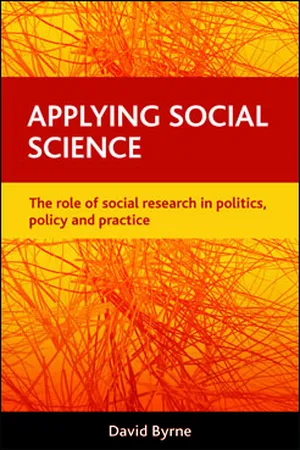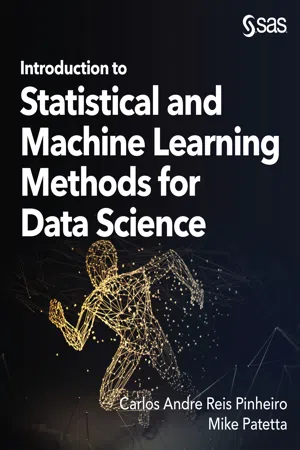Business
Statistical Models
Statistical models are mathematical representations of relationships between variables. They are used to analyze and make predictions based on data. In business, statistical models can help in forecasting sales, identifying trends, and making data-driven decisions. These models can range from simple linear regression to more complex machine learning algorithms.
Written by Perlego with AI-assistance
Related key terms
7 Key excerpts on "Statistical Models"
- eBook - ePub
- P. Kaliraj, T. Devi, P. Kaliraj, T. Devi(Authors)
- 2022(Publication Date)
- Auerbach Publications(Publisher)
The descriptive statistics and the application of inferential statistics constitute a major area, called, applied statistics. A framework for understanding the properties and scope of methods used in applications is provided by theoretical statistics. The statistical concepts and tools framed in theoretical and applied statistics are, in general, applied to various problems that would exist in almost every area of human activity where statistical data are involved. Statistical modeling is one of the various important concepts in the theory of statistics that plays a vital role by providing insightful evaluation and assessment of the available information.Regression, econometric, and time-series (forecast) models are among the various types of Statistical Models which have wider applications in business, economic, and management problems. These models are vitally used by business decision-makers and government policymakers to perform quantitative analyses and business and economic forecasts. The objective of this chapter is to present a brief account of the general framework of forecasting principles, limitations, and procedures that are applied in the fields of business, commerce, economics, and management. The basic forecast models for time series data, such as naïve, moving average, and exponential smoothing models are provided highlighting their significance.3.2 Meaning of ForecastingIn more formal terms, forecasting is defined as a process of predicting or estimating the future based on past and present data and provides information about the potential future events and their consequences for the organization. Forecasting uses many statistical techniques. As a statistical planning tool, it permits the policymakers, managements, and organizations to envisage the future behavior or activity based effectively on the historical or past data. Uncertainty may prevail even when the right decisions could be made by them with their ability to predict future trends. Forecasting can be used as a mechanism to steer such decisions.It is imperative for many sectors or organizations, which may be large or small, private or public, to meet the demands of future conditions with imperfect knowledge. Such situations certainly warrant the use of forecasting either explicitly or implicitly. Though the complications and uncertainty of the future may not be reduced much by forecasts, the insightful information provided by forecasting trends could increase the confidence of the sectors or organizations to make strategic decisions. For further details on the principles of forecasting, one may refer to Hoshmand (2010) and Hanke and Wichern (2014) - eBook - ePub
- Steffen Lauritzen(Author)
- 2023(Publication Date)
- Chapman and Hall/CRC(Publisher)
Chapter 1 Statistical ModelsDOI: 10.1201/9781003272359-11.1 Models and parametrizations
The basic object in mathematical statistics is a statistical model defined formally as follows:Definition 1.1. A statistical model consists of a measure space( X , E )and a family P of probability measures on( X , E ). The space( X , E )is the representation space of the model.The interpretation of a statistical model is that data x is an observed outcomeX = xof a random variable X with values in X and distribution given by an unknown probability measureP ∈ P. The task of the statistician is to say something sensible about P, based on the observation x. This process is known as statistical inference. In the machine learning literature, it is more common to refer to this task as that of learning P from data x.This formulation of the basic statistical problem and associated inference task was introduced by Sir Ronald Aylmer Fisher (1890–1962) in Fisher (1922) , and we shall sometimes refer to such a statistical model as a Fisherian statistical model. An alternative approach to statistical inference is based on a Bayesian statistical model, but we shall only briefly touch on this approach in Section 6.6 .The reader should be aware that the notion of a statistical model as used here is quite different from the notion of a model as used by most scientists. A scientist would rather think of the specific P as the model, rather than the family P . This is a source of considerable confusion, also among statisticians who sometimes use the term ‘true model’ for the specific P. We shall avoid this term in the subsequent developments.The role of a statistical model is primarily to specify the framework within which our reasoning about the problem takes place. Sometimes the model has the purpose of giving a good description of reality, but other times—and quite often—it is rather used as a basis for saying something interesting about reality, for example that certain aspects of the observations do not conform with the model used, thereby providing a basis for further understanding of the reality behind the observations. - eBook - ePub
Manufacturing and Enterprise
An Integrated Systems Approach
- Adedeji B. Badiru, Oye Ibidapo-Obe, Babatunde J. Ayeni(Authors)
- 2018(Publication Date)
- CRC Press(Publisher)
A time series is a sequence of numerical data points in successive order. Generally, a time series is a sequence taken at successive equally spaced points in time. It is a sequence of discrete-time data. For example, in investment analysis, a time series tracks the movement of the chosen data points, such as a security’s price over a specified period of time with data points recorded at regular intervals. One of the main goals of time- series analysis is to forecast future values of the series. A trend is a regular, slowly evolving change in the series level. Changes can be modeled by low-order polynomials. There are three general classes of models that can be constructed for purposes of forecasting or policy analysis. Each involves a different degree of model complexity and presumes a different level of comprehension about the processes one is trying to model. In making a forecast, it is also important to provide a measure of how accurate one can expect the forecast to be. The use of intuitive methods usually precludes any quantitative measure of confidence in the resulting forecast. The statistical analysis of the individual relationships that make up a model, and of the model as a whole, makes it possible to attach a measure of confidence to the model’s forecasts.In time-series models, we presume to know nothing about the causality that affects the variable we are trying to forecast. Instead, we examine the past behavior of a time series in order to infer something about its future behavior. The method used to produce a forecast may involve the use of a simple deterministic model such as a linear extrapolation or the use of a complex stochastic model for adaptive forecasting. One example of the use of time-series analysis would be the simple extrapolation of a past trend in predicting population growth. Another example would be the development of a complex linear stochastic model for passenger loads on an airline. Time-series models have been used to forecast the demand for airline capacity, seasonal telephone demand, the movement of short-term interest rates, and other economic variables. Time-series models are particularly useful when little is known about the underlying process one is trying to forecast. The limited structure in time-series models makes them reliable only in the short run, but they are nonetheless rather useful.In regression models, the variable under study is explained by a single function (linear or non-linear) of a number of explanatory variables. The equation will often be time-dependent (i.e., the time index will appear explicitly in the model), so that one can predict the response over time of the variable under study. The main purpose of constructing regression models is forecasting. A forecast is a quantitative estimate (or set of estimates) about the likelihood of future events which is developed on the basis of past and current information. This information is embodied in the form of a model. This model can be in the form of a single-equation structural model, a multi-equation model or a time-series model. By extrapolating our models beyond the period over which they were estimated, we can make forecasts about near future events. - eBook - ePub
Supply Chain Analytics and Modelling
Quantitative Tools and Applications
- Nicoleta Tipi(Author)
- 2021(Publication Date)
- Kogan Page(Publisher)
As indicated in the previous chapters of this book, a number of commercial software packages are available and can be used to support the application of many of these models. Some of these software packages may have the capability to solve only one aspect of the problem, where others may allow for a more integrated approach. Some of these software packages may require advanced training for the analysts and users to create and operate the models created, which incurs additional costs.In many situations, the models discussed in this section can be implemented when using spreadsheet software. Some of the examples developed in this chapter use Microsoft Excel 2016 for Windows and Minitab software. It is assumed that the reader is familiar with some of the basic functions in Excel, however the functions used and the way these have been considered are detailed in each case.Descriptive models
As discussed in earlier chapters, descriptive models are those looking to answer questions on what happened, why it happened and what is happening now. Data visualization models are critical in supporting the decision-making process and interpreting results. Visualizing data, and using descriptive analytics to understand the relationship between different variables in the data, will help an analyst, for example, to select the most appropriate forecasting model for prediction. Frequency distribution and histograms form part of the descriptive Statistical Models, however as these are visual tools, some descriptive models have been presented in the previous chapter (see Chapter 5 ).Descriptive models are characterized by the use of statistical analysis. A number of Statistical Models can be used in the field of business and management with particular application to the supply chain. Some of these are related in this section, and more examples can be found in Curwin and Slater (2008, 2004), Curwin et al (2013), Evans (2016), Kubiak and Benbow (2016) and Field (2018), to name just a few books in this field. - eBook - ePub
Applying social science
The role of social research in politics, policy and practice
- David Byrne(Author)
- 2011(Publication Date)
- Policy Press(Publisher)
Analysis ... assumes inter alia that the available data forms only a subset of all the data that might have been collected, and then attempts to use the information in the available data to make more general statements about either the larger set or about the mechanism that is producing the data. ... In order to make such statements, we need first to abstract the essence of the data-producing mechanism into a form that is amenable to mathematical and statistical treatment. Such a formulation will typically involve mathematical equations that express relationships between measured ‘variables’ and assumptions about the random processes that govern the outcome of individual measurements. That is the statistical model of the system. Fitting the model to a given set of data will then provide a framework for extrapolating the results to a wider context or for predicting future outcomes, and can often also lead to an explanation of the system. (1998, p ix)Statements relating to ‘the larger set that is producing the data’ are in essence statistical inference. That is to say, they are about what we can say about a population on the basis of a sample from it. Note that while conventional statistical approaches almost always deal with samples, with parts that stand for the whole, in the social sciences we often at least have data about all the cases in a population even if we do not have all possible measurements of those cases. Statements about the mechanism that is producing the data which can be used for generalisation and/or prediction are causal models. In order to predict outcomes we must have some means of relating measurements of elements, usually considered to be variables, which are causal to the outcome, and a description of how they are causal. That description is the model. We should note that despite the usual function of Statistical Models being to predict, some authorities balk at claiming predictive power. For example Everitt and Dunn were far more cautious, and logically correct, when they stated that: ‘In this text ... a model is considered to be a way of simplifying and portraying the structure in a set of data, and does not necessarily imply any causal mechanisms’ (1983, p 5). - eBook - ePub
- Andy Field, Jeremy Miles(Authors)
- 2010(Publication Date)
- SAGE Publications Ltd(Publisher)
moderate fit (i.e. there are some differences between the model and the data but there are also some great similarities). If the engineer uses this model to make predictions about the real world then these predictions may be inaccurate and possibly catastrophic (e.g. the model predicts that the bridge will collapse in a strong wind, causing the real bridge to be closed down, creating 100-mile tailbacks with everyone stranded in the snow; all of which was unnecessary because the real bridge was perfectly safe – the model was a bad representation of reality). We can have some confidence, but not complete confidence, in predictions from this model. The final model (c) is completely different to the real-world situation; it bears no structural similarities to the real bridge and is a poor fit (in fact, it might more accurately be described as an abysmal fit!). As such, any predictions based on this model are likely to be completely inaccurate. Extending this analogy to the social sciences we can say that it is important when we fit a statistical model to a set of data that this model fits the data well. If our model is a poor fit of the observed data then the predictions we make from it will be equally poor.FIGURE 2.2 Fitting models to real-world data (see text for details)JANE SUPERBRAIN 2.1Types of Statistical ModelsAs behavioural and social scientists, most of the models that we use to describe data tend to be linear models . For example, analysis of variance (ANOVA) and regression are identical systems based on linear models (Cohen, 1968), yet they have different names and, in psychology at least, are used largely in different contexts due to historical divisions in methodology (Cronbach, 1957).A linear model is simply a model that is based upon a straight line; this means that we are usually trying to summarize our observed data in terms of a straight line. Suppose we measured how many chapters of this book a person had read, and then measured their spiritual enrichment. We could represent these hypothetical data in the form of a scatterplot in which each dot represents an individual’s score on both variables (see section 4.7 ). Figure 2.3 - Carlos Andre Reis Pinheiro, Mike Patetta(Authors)
- 2021(Publication Date)
- SAS Institute(Publisher)
Chapter 3: Supervised Models – Statistical Approach Chapter OverviewIn this chapter, you will learn about supervised modeling. The term supervised refers to observations or cases where the target is known. Based on the known events, a model is trained to capture the relationship between the inputs and the target. There are several techniques and algorithms used in supervised modeling, including Statistical Models and machine learning models. Chapter 3 covers the Statistical Models, including linear and logistic regression models and decision trees. Chapter 4 covers the machine learning models.The main goals of this chapter include:- Explain the purpose of using statistical supervised models, focusing on linear regression, logistic regression, and decision trees.
- Describe several types of supervised models, the distinct techniques, or algorithms to be used, and the circumstances under which one of them might be used to solve a business problem.
- Interpret the results of the supervised models. Linear regression, logistic regression, and decision tree models are all interpretable. This interpretability can be used to drive business actions based on the models results.
Classification and estimation are common types of predictive models. Classification assumes that the target is a class variable. The target can be a binary class, 0 or 1, yes or no, or it can be a multinomial class, like 1, 2, 3, 4, and 5, or low, medium, and high. For example, is this business event a fraudulent transaction (yes or no)? Estimation assumes that the target is a continuous number. The target can take any value in the range of negative infinity to positive infinity.Both predictive models, classification and estimation, require the following:- Observations/cases/instances:
- A real case comprising a set of attributes that describe the observation.
- Inputs/attributes/variables:
- The measures of the observation, or its attributes. It can be demographic information about the customer, such as age, salary, and marital status.
Index pages curate the most relevant extracts from our library of academic textbooks. They’ve been created using an in-house natural language model (NLM), each adding context and meaning to key research topics.
